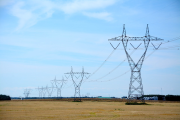It can be intimidating when a land agent knocks on your door and presents you with a lease agreement to be signed. You don't have to sign anything for at least two days, and it's a good idea to carefully read the agreement, even if you have no objections to an oil or gas well on your land. Here are a few things to remember.
Take your time and think about what issues you might want to negotiate. Make a list of things you want to find out and discuss. When the land agent returns, ask for an explanation of anything you don't understand.
When negotiating any conditions that you want added to the lease agreement, remember that some give and take might be necessary. For successful negotiations, both you and the company must be able to obtain your bottom-line objectives and be willing to reach an agreement with each other. If you disagree with what the company wants to do, don't get into a war of words. Ask for help.
Did you know that if you can't reach agreement, you can ask the Alberta Energy and Utilities Board (EUB) to facilitate a meeting? The Board has trained staff who can act as facilitators at informal "kitchen table" meetings between you and the company.
If direct negotiations fail, the EUB can identify key concerns and help you to access its Appropriate Dispute Resolution process. This process can be used for disputes that arise prior to signing a lease agreement or for any issues that cannot be resolved regarding a company's operations. The EUB clearly explains the dispute resolution process on its website at http://www.eub.gov.ab.ca. Click on the "Public Zone" tab at the top of the page, then on "EUB Process" in the drop-down menu. On the left of the EUB process page, you will see "Appropriate Dispute Resolution;" click there to get all the information you will need about "ADR." The first meeting is called the Preliminary Appropriate Dispute Resolution (ADR) Meeting. At this meeting, you and the company will be helped someone experienced in ADR. He or she will clarify the issues and discuss what process would help you to find a solution.
The EUB expects a company not only to reach agreement with the landowner, but also with others in the area who might be directly affected by an activity. The Board sets out the minimum notification and consultation distances in several tables in Directive 56: Energy Development Applications and Schedules. As its name implies, this directive (that used to be called Guide 56) is written for the industry. However, it can be helpful to look at parts of the directive, if you want to find out who a company is required to notify or consult. Chapter 2, Participant Involvement, sets it out quite clearly. You can find this directive on the EUB website by clicking on the "Industry Zone" tab, then on "Regulations, Rules, Requirements" in the drop-down menu. On the left of that page, you will see "Directives." Click there for a list of all the directives and to download Directive 56. If necessary, ask the local library to help you find this on its computer.
In those cases where a company is unable to reach agreement with a landowner or others who are directly affected, it has to tell the EUB when it makes its application for a licence for a well, pipeline or other facility. In fact, it has to submit a non-routine application, in which it outlines the issues of concern. The Board will consider these issues before deciding whether or not to issue a licence.
It is impossible to provide detailed advice in a short article, but remember that if you have questions you can contact the regional EUB office at Wainwright or Red Deer. It can also be helpful to meet with other landowners by joining a surface rights group or synergy group. The EUB can tell you if there is one in your area.
Dr. Mary Griffiths is an Environmental Policy Analyst with the Pembina Institute. She lives in Edmonton, Alberta. Her book, When the Oilpatch Comes to Your Backyard: A Citizens' Guide is a complete guide to interacting with oil and gas companies and is available from the Pembina Institute (www.pembina.org) or by calling the Drayton Valley office at 780.542.6272.







